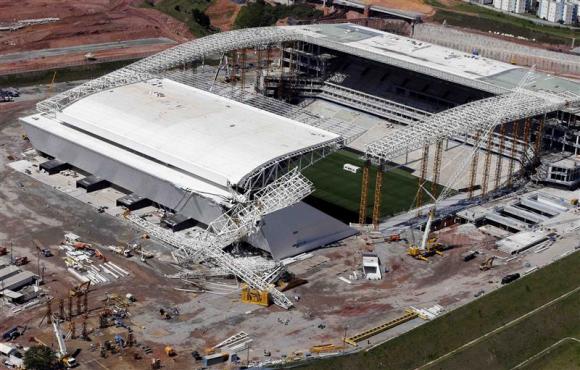(Reuters) – When Brazil first won the right to host the 2014 soccer World Cup, officials knew they would need a modern stadium with more than 65,000 seats in the country’s biggest city.

As it happened, Sao Paulo had just such an arena: Cicero Pompeu de Toledo Stadium, known as “Morumbi,” standing amid a sea of orange-roofed mansions on the western side of the city.
But after nearly three years of negotiations and delays, World Cup organizers instead opted to build a brand-new stadium on the poorer eastern edge of town – a decision that involved a popular former president, one of Brazil’s most bitter soccer rivalries, and no small degree of controversy.
Scrutiny of that decision has intensified following a fatal accident on November 27 at the building site of the new stadium, called Arena Corinthians. A crane collapsed while lifting a 420-tonne piece of roof into place, crushing a portion of the facility’s exterior and killing two workers on the ground below.
The accident has pushed back the stadium’s estimated completion date from December to April, according to FIFA, the governing body of world soccer. That is perilously close to the June 12 date for the World Cup’s opening match, between Brazil and Croatia, which Arena Corinthians is due to host.
Officials are still probing the causes of the crane collapse, and there is no evidence that the company building the stadium, Odebrecht SA, committed any wrongdoing. Odebrecht said in a statement that construction has followed rigorous planning and respected the appropriate speed.
The stadium’s supporters say the 68,000-seat facility will help support economic development in a depressed area of mostly one-story houses some 12 miles east of downtown.
This area has been ignored for years, but this stadium will be a source of pride and much more, Andres Sanchez, a former president of the Corinthians soccer club, said in an interview earlier this year. Corinthians will own the arena when it is completed.
To some critics, the recent accident is particularly galling because they say the stadium should never have been built in the first place. They say its troubled history is emblematic of the poor planning, murky negotiations and wasteful spending that have become big political issues here as the Cup draws closer.
Public outrage over the roughly $3.5 billion being spent to build or renovate Brazil’s 12 World Cup stadiums – including nearly $500 million at Arena Corinthians alone – was a major reason why more than a million Brazilians took to the streets in anti-government protests in June.
President Dilma Rousseff’s approval rating plummeted during the demonstrations, though it has partly recovered as she prepares to run for reelection next October. Many political analysts and other Brazilians believe that protests will erupt again next year when the World Cup starts, especially if preparations are plagued by further tragedy and mismanagement.
I think the more people find out about (Arena Corinthians), the angrier they’ll get, said Paulo Resende, a logistics expert at Fundação Dom Cabral, a leading business school.
RENOVATIONS WERE NEEDED
There was no hint of such a controversy back in 2007 when FIFA granted Brazil – the only country to win the World Cup five times – the right to host the tournament in 2014.
Indeed, Morumbi was a near-consensus choice to host games in Sao Paulo. The stadium was built in the 1950s, but it underwent extensive renovations in the 1990s and remains the city’s venue of choice for big soccer games and concerts, including Madonna and Lady Gaga last year.
The government also planned to finish a new subway link to Morumbi in time for the World Cup.
Morumbi lacked certain standards that FIFA demands for the Cup, such as extra parking and better visibility for fans. Hosting the opening match also brings special needs, such as a media center and space to accommodate visiting heads of state.
So the soccer team that owns the stadium, Sao Paulo Futebol Clube (SPFC), offered several plans for renovations, costing between $130 million and $330 million depending on their scope.
Talks over renovations continued until June 2010, when FIFA declared that Morumbi would be “excluded” from the Cup.
The exact reasons are hotly disputed to this day.
FIFA said SPFC repeatedly failed to present sufficient financial guarantees for the renovations, and that it was time to start seeking alternatives.
But some SPFC officials blamed their long-running feud with Ricardo Teixeira, the powerful head of Brazil’s soccer federation and the country’s point man for World Cup preparations. They accused Teixeira of speaking against their proposals in talks with FIFA because of his recent dispute with the team over television rights, among other conflicts.
Also, they said, Teixeira wanted to use the World Cup as leverage to secure financial and political support to build a stadium for SPFC’s crosstown rival – Corinthians – and thus gain new allies at a time when his leadership was being challenged because of corruption allegations.
The Cup didn’t come to Morumbi because of politics,” Emerson Leão, then SPFC’s coach, said in a 2011 TV interview. “It was all a big lie that was silently accepted.
THE DECISION-MAKERS GO TO GROUND
Several key figures in the decision not to use Morumbi now refuse to discuss it. Teixeira resigned in March 2012 following a new wave of corruption accusations, left Brazil to live in Miami, and “isn’t talking about anything” with the media, his former spokesman said.
Orlando Silva, the sports minister at the time, also resigned following a corruption scandal in 2011. He did not respond to repeated e-mailed requests to discuss Morumbi.
Silva’s replacement, Aldo Rebelo, said in an interview last month that he too had struggled to figure out why Morumbi wasn’t chosen – but that getting the full story proved difficult.
Still, he said he came to the conclusion that building Arena Corinthians “was the only possible alternative” because time was running out to provide a venue and, without it, Sao Paulo could have lost the right to host any World Cup games at all.
Delia Fischer, a FIFA spokeswoman, reiterated that the decision not to use Morumbi resulted from the lack of “financial guarantees for refurbishment.”
What’s undisputed is that the Corinthians club was thrilled by the possibility of having a new stadium and had plenty of political support to get a deal done.
Despite having one of the country’s biggest fan bases, Corinthians is famous within Brazil for never having owned its own stadium, playing in rented facilities instead.
Meanwhile, the club’s best-known fan is Luiz Inacio Lula da Silva, who in 2010 was in his final year as president of Brazil with an approval rating upward of 80 percent.
Thanks in part to Lula’s backing, a plan came together to build Arena Corinthians, using tax incentives and some $200 million in public financing. Speaking during a tour of Brazil’s World Cup stadiums earlier this year, Lula said he believed the best of all, I think, will be Corinthians.
WORRIES OVER THE TIMETABLE
Even after the decision to build the stadium was finalized, it has continued to generate headaches for FIFA and for Brazilian officials – and anger among the greater public.
Arena Corinthians has far exceeded its original budget of 650 million reais ($281 million). It is now expected to cost 1 billion reais or more – about four times as much as the cheapest proposed renovations at Morumbi.
Resende, the logistics expert, questioned not only the stadium’s high costs but also its “dangerous isolation” far from the city’s wealthier areas. He said recent studies have shown that new sports arenas in the United States and elsewhere are of questionable economic value to surrounding communities.
I find (the stadium) to be a series of terrible decisions, Resende said.
Because of the years spent haggling, construction on Arena Corinthians didn’t start until May 2011 – a full year later than most other World Cup stadiums. As a result, the facility has been under unusual time pressure from its inception.
As recently as May, FIFA General Secretary Jerome Valcke publicly warned that Arena Corinthians could lose the right to host World Cup games because, he said, construction might not be finished on time.
They’re going to have to speed things up. That isn’t a threat, Valcke said at a news conference in Brasilia, according to local media.
When the construction accident occurred on November 27, some union leaders representing workers at the site suggested that the stadium’s accelerated timetable may have been a factor.
That kind of pressure leads to mistakes, said Antonio Ramalho, head of one of Sao Paulo’s biggest civil construction unions. Everyone knows that rushing is the enemy of safety.
The operator of the crane that collapsed had been working 18 days straight with no time off, Luiz Antonio Medeiros, a labor ministry official, told reporters on Tuesday.
The company building the stadium, Odebrecht, denied that laborers had excessively long hours. The company also said 32 workers, among the 1,350 or so working on site at the time of the accident, were dedicated to safety, and that personnel received daily safety training.
A final report on the accident’s cause is not expected until later this month.
($1 = 2.30 reais)
(Editing by Todd Benson and Frank McGurty)





